León |
|
|
|
| Übersicht – Contents: | |
Diese Seite ist Teil des Projektes
León |
|
|
|
| Übersicht – Contents: | |
| historische und andere Flaggen – historical and other Flags: | |
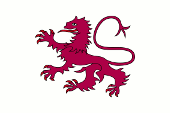 |
11. Jahrhundert / 11th century, |
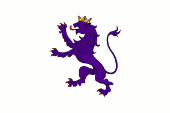 |
inoffizielle Flagge der Region León |
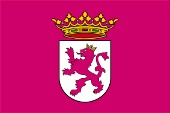 |
"La Purpurada", |
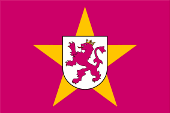 |
Flagge linksgerichteter lokaler Nationalisten |
| Die Flagge des alten Königreichs León war, wie damals üblich eine Wappenflagge. Das heißt, eine Flagge die das Bild des Wappens des Landes (eigentlich des Herrschers) zeigte. Demzufolge ist das Flaggentuch einfarbig weiß mit einem rot-violetten Löwen in der Mitte. In dieser Frühzeit der Flaggen waren diese eigentlich auch nicht so geformt wie unsere heutigen Flaggen. Die Flaggen glichen eher Wappen, die man mit der geraden Seite am Mast befestigte. Der Löwe zeigt rote Krallen und eine rote Zunge und ist golden bekrönt. Die Farbe des Löwen wird wird Morado (Maulbeerfarben) genannt. Dabei kann sie sehr verschieden aussehen, von Violett bis hin zu Lila, auch Rotbraun oder gar Magenta. Genauso wird die Farbe mal Rot, mal Morado, mal Violett und mal Purpur genannt. Es ist nahezu unmöglich hier einen Standard zu finden. Erste Abbildungen des Löwen von León finden sich zu Beginn des 12. Jahrhunderts auf Münzen, vorher wurde ein Kreuz verwendet, und auch auf Siegeln, wobei die Form des Löwen sehr unterschiedlich ausfiel. Erste Darstellungen in Farbe gab es schon Anfang des 11. Jahrhunderts, sie zeigen einen purpurnen (lila) Löwen auf weiß (Silber), am Ende des 12. Jahrhunderts erschien der Löwe in Violett. Es gab aber auch naturfarbene Darstellungen oder auch Abbildungen in Gold. Ab dem Ende des 13. Jahrhunderts trug der Löwe dann auch eine Krone, um die königliche Macht zu unterstreichen. Gerade im alten Königreich war die Heraldik der des Königreichs León und der Stadt León praktisch nicht zu trennen. Nachdem León dynastisch mit Kastilien verschmolzen war trat die Heraldik des Königreichs León in den Hintergrund, wurde nicht weiter betrieben und gepflegt. Natürlich tauchte der Löwe in Wappen und Flaggen des Königreichs Kastilien-León auf, jedoch wurde er ab dem 15. Jahrhundert fast ausschließlich in Rot dargestellt. Jetzt war es an der Stadt León, das heraldische Erbe weiter zu tragen. Der Löwe im Stadtwappen war meist in Violett gehalten, selten in Rot, auch die Flagge der Stadt war einfarbig Rot. 1977 kam es zum Streit, weil für die Flagge des Provinzrats von León die Farbe Purpur gefordert wurde, der alten Traditionen des Landes wegen. Im Jahre 1982, also ein Jahr bevor 1983 die die autonome Gemeinschaft Kastilien-León geschaffen wurde, wurde die Heraldik definiert, die für Kastilien-León einen purpurnen (lila) Löwen vorsieht, was demzufolge amtlich vorgeschrieben wäre. Dennoch wird in der Praxis sehr häufig Violett für den Löwen eingesetzt. Wahrscheinlich hat die Farbe Violett einen gewissen Beigeschmack, denn sie wird mit der umstrittenen Republik Spanien (1931–1939) in Verbindung gebracht, deren Flagge die Farben Rot, Gelb und Violett zeigte, um neben den Farben Kastiliens auch León zu repräsentieren. Politische und kulturelle Gruppen welche die Identität von León erhalten und fördern wollen, oder gar die Unabhängigkeit des Landes wünschen, verwenden heute meist eine Flagge die "La Purpurada" ("Die Purpurne") genannt wird. Sie ist einfarbig purpur und zeigt in der Mitte das Wappen des Königreiches León mit einem purpurnem Löwen. |
The flag of the ancient
Kingdom of León was, as was customary at the time, a flag of arms. That is,
a flag that showed the image of the coat of arms of the country (actually
the ruler). Consequently, the flag bunting is plain white with a red /
purple lion in the center. In this early period of flags, they were actually
not shaped like our flags today either. The flags were more like coats of
arms, which were attached to the mast with the straight side. The lion shows red claws and a red tongue and bears a golden crown. The color of the lion is called morado (mulberry). It can look very different, from violet to purple, also reddish brown or even magenta. Likewise, the color is sometimes called red, sometimes morado, sometimes violet and sometimes purple. It is almost impossible to find a standard here. First depictions of the Lion of León can be found at the beginning of the 12th century on coins, before that a cross was used, and also on seals, whereby the shape of the lion was very different. First representations in color existed already at the beginning of the 11th century, showing a purple (lilac) lion on white (silver), at the end of the 12th century the lion appeared in violet. However, there were also natural-colored representations or even images in gold. Then, from the end of the 13th century, the lion also wore a crown to emphasize the royal power. Especially in the old Kingdom, the heraldry of the Kingdom of León and the City of León was practically inseparable. After León was dynastically merged with Castile, the heraldry of the Kingdom of León receded into the background, was not pursued and maintained. Of course, the lion appeared in coats of arms and flags of the Kingdom of Castile-León, but from the 15th century it was almost exclusively represented in red. Now it was up to the City of León to carry on the heraldic heritage. The lion in the city's coat of arms was mostly purple, rarely red, and the city's flag was also solid red. In 1977, a dispute arose because the color purple was demanded for the flag of the Provincial Council of León, because of the ancient traditions of the country. In 1982, one year before the creation of the autonomous community of Castilla y León in 1983, the heraldry was defined that for Castilla y León a purple (lilac) lion would be officially required. Nevertheless, in practice, violet is very often used for the lion. Probably the color violet has a certain connotation, because it is associated with the controversial Republic of Spain (1931-1939), whose flag showed the colors red, yellow and violet to represent León in addition to the colors of Castile. Political and cultural groups that want to preserve and promote the identity of León, or even desire the independence of the country, today usually use a flag called "La Purpurada" ("The Purple"). It is a solid purple color and shows the coat of arms of the Kingdom of León with a purple lion in the center. |
| Quelle/Source: 1.) Wikipedia (ES), 2.) Wikipedia (ES), 3.) Wikipedia (ES), Wikipedia (DE), Volker Preuß | |
Wappen – Coat of Arms: |
|
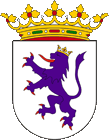 |
Wappen von León – coat of arms of León, Quelle/Source, nach/by: Wikipedia (DE) |
| Das Wappen des alten Königreichs León ist einfarbig weiß (silbern) mit einem rot-violetten Löwen in der Mitte. Das Wappen ist ein "redendes Wappen", denn Löwe heißt auf Leónesisch "Llión" und auf Spanisch "León". Der Löwe zeigt rote Krallen und eine rote Zunge und ist golden bekrönt. Die Farbe des Löwen wird wird Morado (Maulbeerfarben) genannt. Dabei kann sie sehr verschieden aussehen, von Violett bis hin zu Lila, auch Rotbraun oder gar Magenta. Genauso wird die Farbe mal Rot, mal Morado, mal Violett und mal Purpur genannt. Es ist nahezu unmöglich hier einen Standard zu finden. Erste Abbildungen des Löwen von León finden sich zu Beginn des 12. Jahrhunderts auf Münzen, vorher wurde ein Kreuz verwendet, und auch auf Siegeln, wobei die Form des Löwen sehr unterschiedlich ausfiel. Erste Darstellungen in Farbe gab es schon Anfang des 11. Jahrhunderts, sie zeigen einen purpurnen (lila) Löwen violetten Löwen auf weiß (Silber), am Ende des 12. Jahrhunderts erschien der Löwe in Violett. Es gab aber auch naturfarbene Darstellungen oder auch Abbildungen in Gold. Ab dem Ende des 13. Jahrhunderts trug der Löwe dann auch eine Krone, um die königliche Macht zu unterstreichen. Gerade im alten Königreich war die Heraldik der des Königreichs León und der Stadt León praktisch nicht zu trennen. Nachdem León dynastisch mit Kastilien verschmolzen war trat die Heraldik des Königreichs León in den Hintergrund, wurde nicht weiter betrieben und gepflegt. Natürlich tauchte der Löwe in Wappen und Flaggen des Königreichs Kastilien-León auf, jedoch wurde er ab dem 15. Jahrhundert fast ausschließlich in Rot dargestellt. Jetzt war es an der Stadt León, das heraldische Erbe weiter zu tragen. Der Löwe im Stadtwappen war meist in Violett gehalten, selten in Rot, auch die Flagge der Stadt war einfarbig Rot. 1977 kam es zum Streit, weil für die Flagge des Provinzrats von León die Farbe Purpur gefordert wurde, der alten Traditionen des Landes wegen. Im Jahre 1982, also ein Jahr bevor 1983 die die autonome Gemeinschaft Kastilien-León geschaffen wurde, wurde die Heraldik definiert, die für Kastilien-León einen purpurnen (lila) Löwen vorsieht, was demzufolge amtlich vorgeschrieben wäre. Dennoch wird in der Praxis sehr häufig Violett für den Löwen eingesetzt. Wahrscheinlich hat die Farbe Violett einen gewissen Beigeschmack, denn sie wird mit der umstrittenen Republik Spanien (1931–1939) in Verbindung gebracht, deren Flagge die Farben Rot, Gelb und Violett zeigte, um neben den Farben Kastiliens auch León zu repräsentieren. |
The coat of arms of the
ancient Kingdom of León was a plain white (silvery) shield with a red and
purple lion in the center. The coat of arms is a "talking coat of arms"
because lion is called "Llión" in Leónese language and "León" in Spanish
language. The
lion shows red claws and a red tongue and bears a golden crown. The color of
the lion is called morado (mulberry). It can look very different, from
violet to purple, also reddish brown or even magenta. Likewise, the color is
sometimes called red, sometimes morado, sometimes violet and sometimes
purple. It is almost impossible to find a standard here. First depictions of
the Lion of León can be found at the beginning of the 12th century on coins,
before that a cross was used, and also on seals, whereby the shape of the
lion was very different. First representations in color existed already at the beginning of the 11th century, showing a purple (lilac) lion on white (silver), at the end of the 12th century the lion appeared in violet. However, there were also natural-colored representations or even images in gold. Then, from the end of the 13th century, the lion also wore a crown to emphasize the royal power. Especially in the old Kingdom, the heraldry of the Kingdom of León and the City of León was practically inseparable. After León was dynastically merged with Castile, the heraldry of the Kingdom of León receded into the background, was not pursued and maintained. Of course, the lion appeared in coats of arms and flags of the Kingdom of Castile-León, but from the 15th century it was almost exclusively represented in red. Now it was up to the City of León to carry on the heraldic heritage. The lion in the city's coat of arms was mostly purple, rarely red, and the city's flag was also solid red. In 1977, a dispute arose because the color purple was demanded for the flag of the Provincial Council of León, because of the ancient traditions of the country. In 1982, one year before the creation of the autonomous community of Castilla y León in 1983, the heraldry was defined that for Castilla y León a purple (lilac) lion would be officially required. Nevertheless, in practice, violet is very often used for the lion. Probably the color violet has a certain connotation, because it is associated with the controversial Republic of Spain (1931-1939), whose flag showed the colors red, yellow and violet to represent León in addition to the colors of Castile. |
| Quelle/Source: 1.) Wikipedia (ES), 2.) Wikipedia (ES), 3.) Wikipedia (ES), Wikipedia (DE), Volker Preuß | |
|
Karte der historischen Iberischen Königreiche – Map of the historic Iberian Kingdoms |
| ca. 1220 |
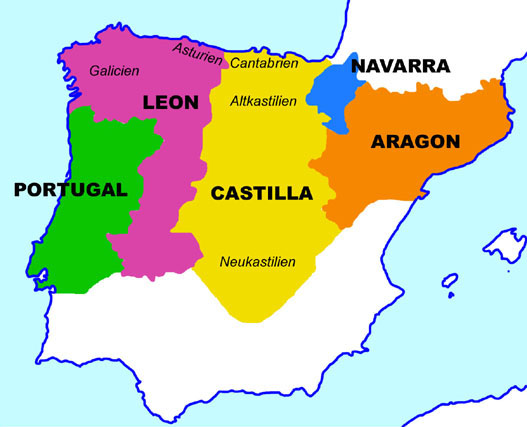 |
| Landkarte/map by: Volker Preuß |
| Zahlen und Fakten – Numbers and Facts: | |
|
|
|
|
|
|
|
|
| Die
Geschichte Leóns beginnt im Prinzip mit dem Königreich Oviedo/Asturien.
Jedoch entsteht León tatsächlich erst mit der Erbteilung dieses Königreichs
im Jahre 910. Frühzeit ·
Besiedlung des heutigen Asturiens durch das indogermanische Volk der
Kantabrer (lateinisch: Cantabri) León ist zwischen 1230 und 1479 fester Bestandteil des Königreichs Kastilien-León. Im Jahre 1469 heiratet Isabella I., Königin von Kastilien-León Ferdinand II., den Prinzen und Thronfolger von Aragónien. Beide werden 1479 zu Königen von Spanien gekrönt, und somit Kastilien-León und Aragónien zu einem einzigen Land vereinigt. Das alte León wird damit Bestandteil Spaniens und sinkt zu einer rein landschaftlichen Bedeutung herab. 1808–1813
· León ist durch französische Truppen besetzt |
| The
history of León starts in principle with the Kingdom of Oviedo/Asturia. But
in reality León came into being not until the heritage-division of that
kingdom in the year 910. early age ·
settlement of the today's Asturia by the Indo-European people of the
Cantabrians (Latin: Cantabri) León is between the years 1230 and 1479 a firm component of the Kingdom of Castile-León. Isabella I. Queen of Castile-León marrys Ferdinand II., the Prince and Throne-Successor of Aragon in the year 1469. They both become crowned to the Kings of Spain in 1479 and in this way Castile-León and Aragon become united to one country. The old León becomes in this way a component of Spain and becomes reduced to an only regional importance. 1808–1813
· León is occupied by French troops |
| Quelle/Source: Wikipedia (ES), RetroBib Retrobibliothek, Volker Preuß |
| Der Name
des Landes geht auf die Stadt "León" zurück. Im Jahre 924 verlegte der König
von Oviedo seine Residenz in diese Stadt, und der Name der Stadt wurde von
dieser Zeit an auf das ganze Land übertragen. Der Name der Stadt geht auf die Zeit der Römer zurück und entstammt dem Wort "Legio", dem Legionslager der hier stationierten Legion VII. Gemina. |
The name of the country has its roots in the Town of "León". The King of Oviedo transfered his residence into that town in 924, and from that point in time the name of the town was transmited over the whole country. The name of the town has its roots in the times of the Romans and comes from the word "Legio", the legion camp of the here stationed Legion VII. Gemina. |
| Quelle/Source: RetroBib Retrobibliothek, Volker Preuß | |